Inside The New York Botanical Garden
Wildlife
Posted in Wildlife on May 21 2009, by Plant Talk
Parents Believed to Be Fordham U. Pair
 |
Richard Fleisher is a professor of Political Science at Fordham University. He has been keeping watch at the red-tailed hawk nest at The New York Botanical Garden and chronicling the activity of the nestlings. Additional photos of the red-tailed hawks can be seen on his Web site.
|
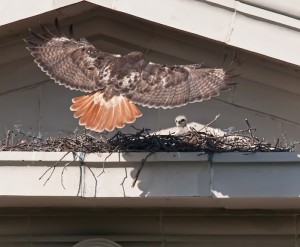 For the past four years I have watched and photographed two red-tailed hawks nest, hatch, nurture, and successfully fledge 11 young red-tails at Fordham University. The pair were named “Hawkeye” after Fordham alum Alan Alda’s character in M*A*S*H and “Rose” for Rose Hill, the Bronx campus of the University. Hawkeye is lighter in color than Rose, who has a distinctive band on her right leg. I had grown accustomed to watching this pair each spring as they fortified the nest on Collins Hall in preparation of another breeding cycle. In April the eggs would hatch, and soon young hawks that looked like little cotton balls would be visible through my scope. Very quickly these hatchlings (usually three) would get bigger, and by June they would be seen fledging (leaving the nest).
For the past four years I have watched and photographed two red-tailed hawks nest, hatch, nurture, and successfully fledge 11 young red-tails at Fordham University. The pair were named “Hawkeye” after Fordham alum Alan Alda’s character in M*A*S*H and “Rose” for Rose Hill, the Bronx campus of the University. Hawkeye is lighter in color than Rose, who has a distinctive band on her right leg. I had grown accustomed to watching this pair each spring as they fortified the nest on Collins Hall in preparation of another breeding cycle. In April the eggs would hatch, and soon young hawks that looked like little cotton balls would be visible through my scope. Very quickly these hatchlings (usually three) would get bigger, and by June they would be seen fledging (leaving the nest).
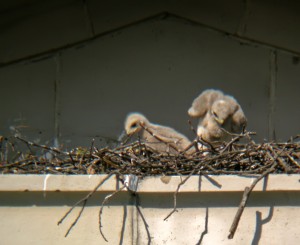 This spring, however, was different—there were no signs of the adult pair engaging in this practice. For sure, in early winter I would see them perched atop some of their favorite high spots on the campus. But when February became March and there continued to be no activity, I figured something was up. Sure enough, I got word that a pair of red-tails was nesting on the Library building at the Botanical Garden. I gathered my equipment, including my scope, cameras, 500mm lens, and tripod, to investigate the report of this new nest.
This spring, however, was different—there were no signs of the adult pair engaging in this practice. For sure, in early winter I would see them perched atop some of their favorite high spots on the campus. But when February became March and there continued to be no activity, I figured something was up. Sure enough, I got word that a pair of red-tails was nesting on the Library building at the Botanical Garden. I gathered my equipment, including my scope, cameras, 500mm lens, and tripod, to investigate the report of this new nest.
Though I cannot be sure, I am fairly confident that the pair of red-tails in the Botanical Garden is the same pair that spent the past four years on the Fordham campus. The similarities between the two nests are quite striking—both were built on a pediment of a frequently used building. In addition, it strikes me as too much of a coincidence that the same year the Fordham nest was abandoned a new nest was built by red-tailed hawks at NYBG. Finally, I got a close-up photo of the female and can see that she has a band on her right leg. (For more on the debate about whether the pair is Hawkeye and Rose, click here.)
As was the case in previous years, the pair produced three increasingly active hatchlings, which are now visible in the nest.
To learn more about the Botanical Garden red-tailed hawk nestlings…
Read More
Posted in Programs and Events, Wildlife on April 24 2009, by Plant Talk
Expect Warblers, Wood Ducks, More on this Weekend’s Bird Walks
 |
Debbie Becker leads a free bird walk at the Garden every Saturday from 11 a.m. to 12:30 p.m., beginning at the Reflecting Pool in the Leon Levy Visitor Center. This weekend, she’ll also lead a walk on Sunday, same time and place.
|
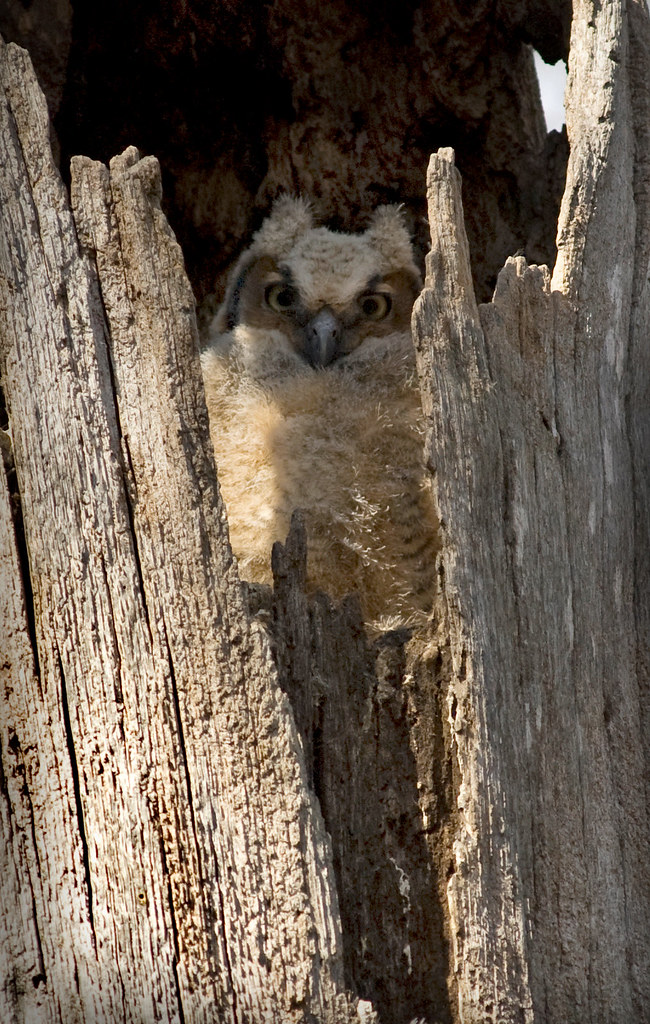 Spring has sprung at NYBG!
Spring has sprung at NYBG!
The phoebe, spring’s harbinger, has been singing its wonderful namesake song throughout the forest. Wood thrush are chiming in along with white-throated sparrows, tufted titmice, and cardinals.
While some birds are singing to lure a mate, some of our larger predators are already proud parents. Our red-tailed hawks appear to have one baby in their nest, built on a cliff-like shelf of the Library building. Mom and pop can be seen flying in and out with tasty morsels to feed the nestling.
Our baby great horned owls fledged their nest in the Forest. Last Saturday, only one baby was left in the nest (see photo) with Dad watching over him like a hawk (or should I say owl). The other owlet was somewhere in the Forest with Mom, learning how to fly and watching her hunt. Earlier this week, the second baby also fledged and now birders are treated to a spectacular show of watching them flap their brand-new wings and hop from branch to branch.
Warblers are beginning to invade the Garden. Some birders I know save all their vacation days for the last week of April and first week of May to look for these gems. Warblers are small, colorful birds that migrate from as far south as South America to the far northern reaches of the United States and southern Canada. Escaping predators and feeding on newly hatched insects, they travel up the eastern coast in the tens of thousands every April and May to their breeding grounds. This is the only chance each year to see these long-distance travelers in their brilliant breeding plumage, and birding NYBG gives you every opportunity to observe them. Last Saturday’s walk yielded a palm warbler, pine warbler, and yellow-rumped warbler.
To learn more about the birds at the Botanical Garden…
Read More
Posted in Wildlife on April 14 2009, by Plant Talk
  |
Wayt Thomas is the Elizabeth G. Britton Curator of Botany in the Institute of Systematic Botany. Stella Sylva is Administrative Curator in the William and Lynda Steere Herbarium. |
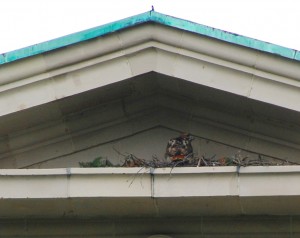 The pair of red-tailed hawks (Buteo jamaicensis) nesting on the Library building appear to be consistently present at the nest although the female is usually not visible when sitting. So, although we cannot say for sure, it is likely that she has laid eggs and is brooding.
The pair of red-tailed hawks (Buteo jamaicensis) nesting on the Library building appear to be consistently present at the nest although the female is usually not visible when sitting. So, although we cannot say for sure, it is likely that she has laid eggs and is brooding.
Their nest is in a small triangular alcove near the top of the front face of the building on the east side (see photos). The close-up photo captures the female stretching her wings and preening herself. Afterward, she went back to the middle of the nest, hunkered down, and disappeared from view. If all goes well, the eggs will hatch sometime this month. We’ll keep you posted when we find out more.
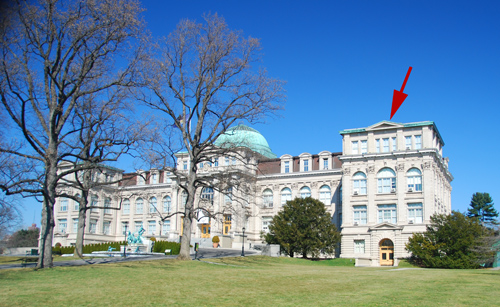
Photos by Wayt Thomas
Posted in Wildlife on March 31 2009, by Plant Talk
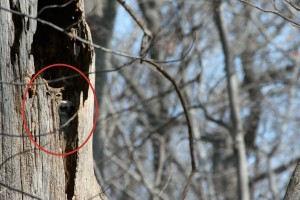
Click photo to enlarge.
Photo by Debbie Becker
Posted in Programs and Events, Wildlife on March 27 2009, by Plant Talk
Saying Hello to New Arrivals and Goodbye to a Friend
 |
Debbie Becker leads a free bird walk at the Garden every Saturday from 11 a.m. to 12:30 p.m., beginning at the Reflecting Pool in the Leon Levy Visitor Center.
|
 Spring has sprung at NYBG. The phoebe, spring’s harbinger, has arrived. A beautiful phoebe was spotted down by Twin Lakes bobbing its tail and calling. Ruby-crowned kinglets, brown creepers, and a juvenile eastern kingbird were also spotted on last Saturday’s walk.
Spring has sprung at NYBG. The phoebe, spring’s harbinger, has arrived. A beautiful phoebe was spotted down by Twin Lakes bobbing its tail and calling. Ruby-crowned kinglets, brown creepers, and a juvenile eastern kingbird were also spotted on last Saturday’s walk.
Perhaps the best indication of spring is seeing the mating rituals that some of the birds perform. The male mockingbird does a dance on the lawn by extending his wings and flashing his white stripes. The female, who looks exactly like the male, is an onlooker who watches from afar. She may judge him on his display or wait further to hear the kaleidoscope of songs that emanate from his vocal cords when he is high atop a tree. Many mockingbirds mock sounds they hear in their vicinity. NYBG mockers often imitate the other birds at NYBG along with alarm systems from cars and sometimes screeching—like the sounds a child might make. The female only mocks in the fall, leaving the spring air open for her suitor’s song.
Read more about birds at the Garden and check out all of this weekend’s programming after the jump.
Read More
Posted in Wildlife on March 24 2009, by Plant Talk
  |
Wayt Thomas is the Elizabeth G. Britton Curator of Botany in the Institute of Systematic Botany. Stella Sylva is Administrative Curator in the William and Lynda Steere Herbarium. |
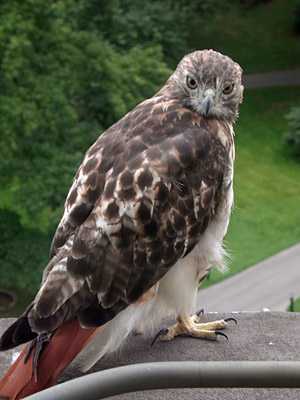
Photo by Tony KirchgessnerFor the past several weeks a pair of red-tailed hawks (Buteo jamaicensis) has been building a nest on the Library building. Their nest is in a small triangular alcove near the top of the front face of the building on the east side (see photos)—they swoop by our office windows on their way to and from the nest.
Last year they started building a nest here but changed their mind and went elsewhere—Fordham University, according to Debbie Becker, who leads the Saturday morning bird walks at the Botanical Garden. This year the hawks seem to be serious. Two weeks ago they were engaged in a very active courtship display and mated several times a day.
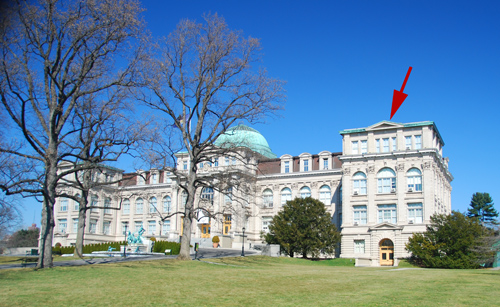
Photo by Wayt ThomasRed-tailed hawk pairs are monogamous, with females (2–4.5 lbs.) larger than males (1.5–3 lbs). The adults have a dark brown back with a pale underbelly and a darker band across the belly; the tail is brick-red above and pinkish below. Our pair is unusual in that they are accompanied by a third hawk—rarely, a second female may help tend the nest and feed the young. This immature bird is an offspring of the pair’s from last year. If everything proceeds according to what we know about these hawks, 1 to 3 eggs will be laid in late March or April—we’ll keep you posted.
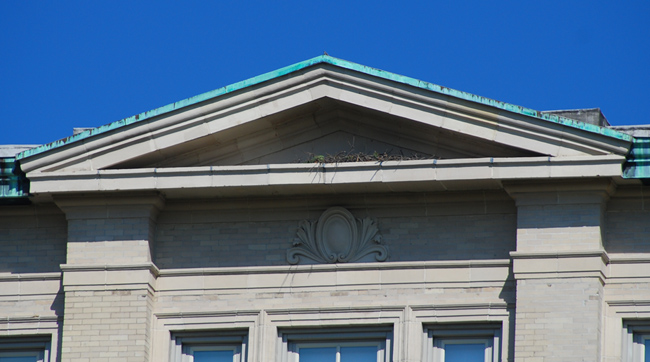
Photo by Wayt ThomasRed-tailed hawks usually feed on small mammals or birds and their preferred habitat is a mix of forest and open areas, such as we have here on the Garden grounds. Their diet consists primarily of squirrels, pigeons, small birds, and rabbits. We don’t know if they are part of the Garden’s Integrated Pest Management plan, but there are fewer squirrels than usual in front of the Library building.
Posted in Programs and Events, Wildlife on February 20 2009, by Plant Talk
Birders Treated to Uncommon Sightings and Start of Mating Season
 |
Debbie Becker leads a free bird walk at the Garden every Saturday from 11 a.m. to 12:30 p.m., beginning at the Reflecting Pool in the Leon Levy Visitor Center.
|
 The other day I watched two male house sparrows competing for the attention of a female bird who seemed totally disinterested in their mating dance. With tail feathers extended they jumped, hopped, and vied for her attention. She seemed distracted and eventually flew away leaving the two male birds confused and looking for another female to shower with attention.
The other day I watched two male house sparrows competing for the attention of a female bird who seemed totally disinterested in their mating dance. With tail feathers extended they jumped, hopped, and vied for her attention. She seemed distracted and eventually flew away leaving the two male birds confused and looking for another female to shower with attention.
February marks the beginning of spring for many birds. It is the start of their mating season. Even though the temperature is hovering around 30 degrees and remnants of snow are on the ground, for birds love is in the air. Perhaps Valentine’s Day was created with birds in mind. What reasonable human really thinks about love during the coldest month of the year? Roses wilt, balloons deflate, and chocolate gets hard in the February frost. But for birds, their warm little bodies and courtship rituals begin to stir as tiny buds form on early blooming trees.
Bird watching has long been regarded as an act of love. For those of us who bundle up in the winter and drudge along snow-laden pathways in the Garden, it is a yearning of the heart that keeps us warm and drives us on. Our quest to see the owls, hear the mourning doves cry, watch the red-tailed hawks soar above, and feed the chickadees from our palms are all acts of unselfish and undying love. What else would motivate us to wake up early on a Saturday morning, don layers of clothes, gloves, boots, hand warmers, hats, and scarfs to brave the cold winds of February and March to go birding.
This year especially, the birding lovebug has bitten many. Because of the global changes and an unusually cold winter, many birds that normally are residents of Canada and the northeastern United States have been driven south by snow and an inability to find food. Much to the delight of birders in New York City and Long Island, white-winged crossbills, snow buntings, lapland longspur, pine siskins, snowy owls, snow geese, long-eared owls, and northern saw-whet owls, and bald eagles have been visiting our area. Earlier this month in the Garden 15 white-winged crossbills delighted a large group of birders with their chatter and acrobatic behavior as they hung from pine cones searching for food. We ran after them as they flew from tree to tree, careful not to slip on the ice but eager to see a sure life-bird for everyone on the bird tour.
Love is a universal feeling, and perhaps birders feel love a bit deeper than most. It is a love for the hobby of birding that drives us to preserve the natural habitats of our feathered friends. We may protest in the form of letters or e-mails about any habitat that is going to be torn down for a shopping center or housing development. Bird lovers will go that extra mile to keep secret an owl roost or to protect the location of a rare bird. I have witnessed passionate debates over the identification of an unrecognizable avian visitor.
Perhaps no other hobby elicits participation from a such a varied number of people. On my bird walks I have met students, politicians, lawyers, doctors, designers, secretaries, teachers, retirees, world travelers, consultants, photographers, writers, and more. The one common thread is the love of birding. And in this month of February with cupid looming about and the beginning of the spring mating season at hand, I hope to meet more people in love with the act of birding on my Saturday bird walks.
Check out all of Saturday’s programming.
Check out all of Sunday’s programming.
Posted in Programs and Events, Wildlife on January 23 2009, by Plant Talk
Colors of Cardinals, Ducks, and More Dazzle Against the Snow
 |
Debbie Becker leads a free bird walk at the Garden every Saturday from 11 a.m. to 12:30 p.m., beginning at the Reflecting Pool in the Leon Levy Visitor Center.
|
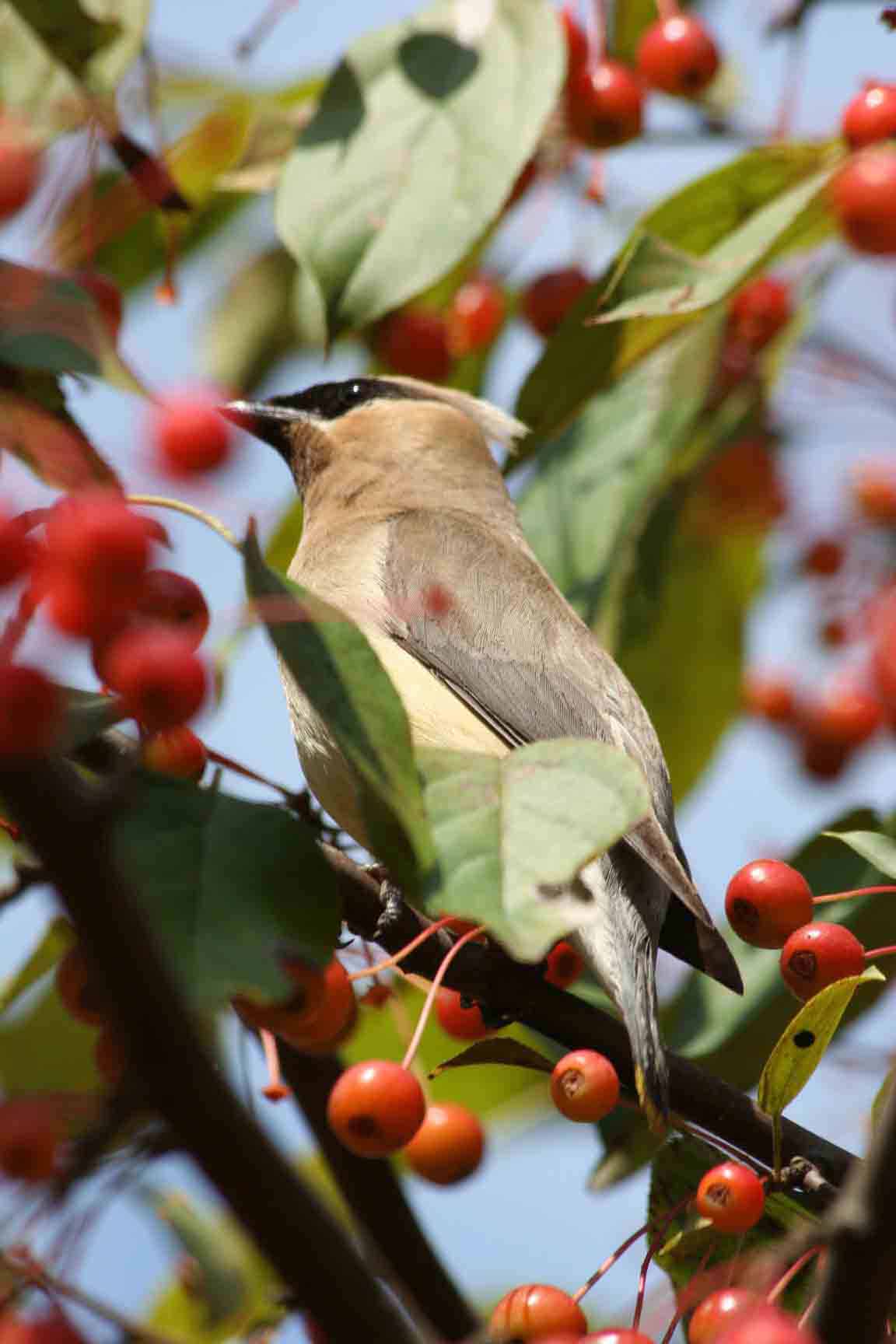 Winter birding at NYBG is always a delight. Once the deciduous trees have shed their leaves all is visible. Streaks of winter sun embrace the Forest and ignite the trees in deep silhouettes and wonderful brown hues. There is something about the frosty sunlight that brings out the vibrant color of the birds. The red-bellied woodpecker’s cap glows in red amber as the bird climbs a tree barking for attention. The northern cardinals are so brilliant in the sun as they sit on the bare branches—their red and orange feathers a sharp contrast to the white snow and brown tree stems. Even the blue jays’ cerulean feathers glow like a Matisse as the birds peck around the snow for morsels to eat.
Winter birding at NYBG is always a delight. Once the deciduous trees have shed their leaves all is visible. Streaks of winter sun embrace the Forest and ignite the trees in deep silhouettes and wonderful brown hues. There is something about the frosty sunlight that brings out the vibrant color of the birds. The red-bellied woodpecker’s cap glows in red amber as the bird climbs a tree barking for attention. The northern cardinals are so brilliant in the sun as they sit on the bare branches—their red and orange feathers a sharp contrast to the white snow and brown tree stems. Even the blue jays’ cerulean feathers glow like a Matisse as the birds peck around the snow for morsels to eat.
Perhaps the most spectacular sight in winter are the ducks on the Bronx River. White-and-crimson-orange hooded mergansers bob in the gentle flow of the river, their white heads parallel to the white snow on the river’s banks. The female with her spiked burgundy head is a sharp contrast and a delight to watch as she dives under the water searching for food.
Cedar waxwings dressed in yellow, red, and beige with a black mask pop yellow, red, and purple crabapples off the branches and into their beaks, making the perfect palette of color come alive.
Tiny black, gray, and white chickadees dance on the sweet gums’ brown sticky seed balls, pecking inside for the last of the autumn treat. Flocks of white-throated sparrows dance in the oak leaves on the ground, hopping back and forth in efforts to dislodge a hibernating spider from its berth. It is a well-choreographed movement that can be played in one’s mind to Beethoven’s Fifth.
One of the great joys of winter birding is hand-feeding chickadees. It is at this time of year that the chickadees, tufted titmice, and occasionally a cardinal are apt to land in one’s outstretched palm if you offer black oil sunflower seeds or roasted peanuts. The birds need the food for nourishment and to keep warm during the cold days of winter. Chickadee use a technique of shivering to keep their body temperatures high enough to survive and the protein from the sunflower and peanuts give them the fuel to perform the shivering technique.
Red-tailed hawks, Cooper’s hawks, and sharp-shinned hawks are also quite visible as they quietly sit on a branch waiting to pounce on their next victim.
In the quietness of the snow, in the shadows of the winter sun, the birds often reflect the silence of the season with a warm melody of song.
Check out Saturday’s programming
Check out Sunday’s programming
Posted in Learning Experiences, Programs and Events, Wildlife on December 12 2008, by Plant Talk
Here’s What You May See on the Tally
 |
Debbie Becker leads a free bird walk at the Garden every Saturday from 11 a.m. to 12:30 p.m., beginning at the Reflecting Pool in the Leon Levy Visitor Center. Join her tomorrow, December 13, for the 2008 New York Botanical Garden Bird Count.
|
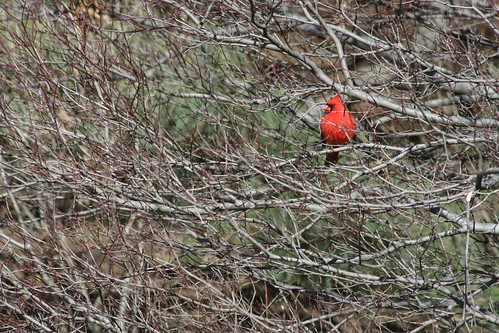 Every year at this time, birders flock to the parks and woods across the country and beyond for National Audubon Society’s annual Christmas Bird Count. From dawn’s early light until dusk birders count all the birds they can find using a specific method and within precise geographic areas. At the end of the day the counts are tallied and compared to numbers from previous years. The information is used to determine if a bird species is in trouble or declining. Past revelations included lower than usual numbers of house finches, most likely due to conjunctivitis, and decimated crow numbers, presumably due to West Nile Virus. Occasionally, a rarity will pop up on the count as birders scour the shorelines, forests, and meadows looking for elusive visitors to their areas. Past special sightings at the Botanical Garden, which is part of Audubon’s 84-year-old Bronx-Westchester count, include common redpolls, chipping sparrows, pine warblers, Baltimore orioles, and a merlin.
Every year at this time, birders flock to the parks and woods across the country and beyond for National Audubon Society’s annual Christmas Bird Count. From dawn’s early light until dusk birders count all the birds they can find using a specific method and within precise geographic areas. At the end of the day the counts are tallied and compared to numbers from previous years. The information is used to determine if a bird species is in trouble or declining. Past revelations included lower than usual numbers of house finches, most likely due to conjunctivitis, and decimated crow numbers, presumably due to West Nile Virus. Occasionally, a rarity will pop up on the count as birders scour the shorelines, forests, and meadows looking for elusive visitors to their areas. Past special sightings at the Botanical Garden, which is part of Audubon’s 84-year-old Bronx-Westchester count, include common redpolls, chipping sparrows, pine warblers, Baltimore orioles, and a merlin.
Twenty years ago I started the Garden’s own unofficial bird count, a low-keyed version that is fun and educational. Instead of gathering at 5 a.m., we meet at 11 a.m. and set out to count the birds at NYBG. I keep a list of the most common New York City birds and put strokes near their names as we spot them flying by. The two decades of data from our informal count confirms the trends found in the Audubon count.
Read about the birds likely to be found on the count and of a special sighting last year after the jump.
UPDATE 12/18/08: Bird walk results
Count day was sunny and cold, with temperatures in the 20s. Nineteen people participated; the count lasted three hours and turned up 24 species and 105 birds overall. Highlights of the day included a northern shoveler at Twin Lakes, both the female and male great horned owls in the Forest, and a goshawk, for the second year in a row, by the Prop Range. A flock of house finches, a brown creeper, and a house wren also were good finds. The full list is noted here.
House finch: 12; House sparrow: 3; White-throated sparrow: 5; Black-capped chickadee: 8; Dark-eyed junco: 15; House wren: 1; American crow: 1; Blue jay: 2; Northern cardinal: 2; Mourning dove: 9; American robin: 3; Red-bellied woodpecker: 1; Downy woodpecker: 1; Tufted titmouse: 3; White-breasted nuthatch: 1; Brown creeper: 1; Northern mockingbird: 3; Hermit thrush: 2; Great horned owl: 2; Red-tailed hawk: 2; Northern goshawk: 1; Northern shoveler: 1; Mallard: 23; Hooded merganser: 3; (Last week, 30 wood ducks were counted.)
Read More
Posted in Programs and Events, Wildlife on November 7 2008, by Plant Talk
Has the Resident Pair Been Displaced by Youth?
 |
Debbie Becker leads a free bird walk at the Garden every Saturday from 11 a.m. to 12:30 p.m., beginning at the Reflecting Pool in the Leon Levy Visitor Center.
|
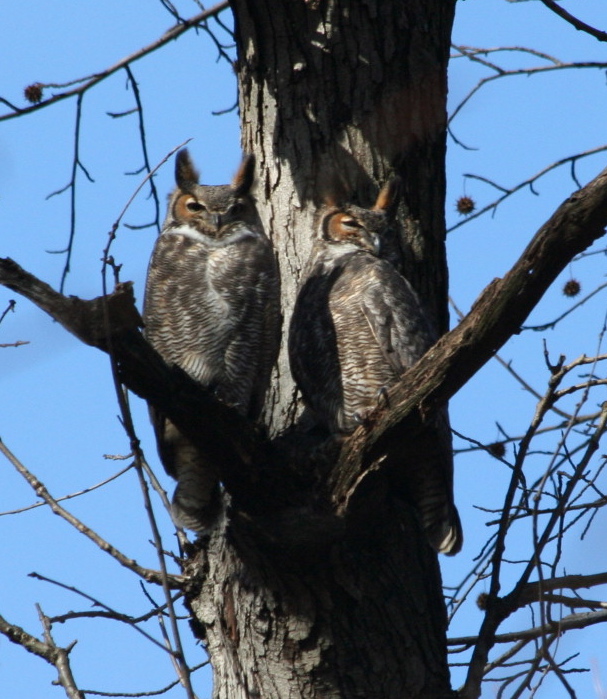 Now that the trees are shedding their leaves, I’ve begun taking the weekly Bird Walk group through the Forest in hopes of seeing the resident great horned owls. Sure enough, a couple of weeks ago we discovered a large great horned owl (GHO) perched on a low branch.
Now that the trees are shedding their leaves, I’ve begun taking the weekly Bird Walk group through the Forest in hopes of seeing the resident great horned owls. Sure enough, a couple of weeks ago we discovered a large great horned owl (GHO) perched on a low branch.
At first we could not decided whether it was the adult male or the adult female of the regular pair. (The male is at left in the photo, taken last year during their courting phase.) Upon closer inspection we decided it was neither; it was one of their offspring. It has been months since the babies fledged the nest. So what was this immature owl still doing in the Forest? Great horned owls reach sexual maturity after two years, but their territoriality begins almost immediately after they learn to feed themselves.
Could it be that the mature male has reached the end of his reign as the only male owl in the Forest? He is, after all, more than 20 years old. That is a long life span for a wild owl (captive GHOs can live up to 30 years), although the owl pairs in Pelham Bay Park and Van Cortlandt Park have been breeding for almost the same amount of time. Human encroachment has given them a unique domain: The highways and complexes around our forests have created a closed habitat, ensuring enough food, safety from many predators, and a long life span.
The time comes for all creatures when they get too old to go on or they are pushed out by the next generation. Observing the younger owl in the Forest saddened me and the birders on the tour, as we know it could only mean one thing: Our resident great horned owls may be pushed out by a more vibrant male that will take over the Garden’s Forest and begin looking for his own mate. It is a somber time for the resident birders. We are all getting older and in danger of being replaced by someone fresher and younger. Sadly, to everything there is a season, even for the great horned owls of The New York Botanical Garden.
Join us on Saturdays at 11 a.m. to look for the great horned owls and other birds of the Garden.
Learn more about the Garden’s resident great horned owls after the jump.
Read More

 For the past four years I have watched and photographed two red-tailed hawks nest, hatch, nurture, and successfully fledge 11 young red-tails at Fordham University. The pair were named “Hawkeye” after Fordham alum Alan Alda’s character in M*A*S*H and “Rose” for Rose Hill, the Bronx campus of the University. Hawkeye is lighter in color than Rose, who has a distinctive band on her right leg. I had grown accustomed to watching this pair each spring as they fortified the nest on Collins Hall in preparation of another breeding cycle. In April the eggs would hatch, and soon young hawks that looked like little cotton balls would be visible through my scope. Very quickly these hatchlings (usually three) would get bigger, and by June they would be seen fledging (leaving the nest).
For the past four years I have watched and photographed two red-tailed hawks nest, hatch, nurture, and successfully fledge 11 young red-tails at Fordham University. The pair were named “Hawkeye” after Fordham alum Alan Alda’s character in M*A*S*H and “Rose” for Rose Hill, the Bronx campus of the University. Hawkeye is lighter in color than Rose, who has a distinctive band on her right leg. I had grown accustomed to watching this pair each spring as they fortified the nest on Collins Hall in preparation of another breeding cycle. In April the eggs would hatch, and soon young hawks that looked like little cotton balls would be visible through my scope. Very quickly these hatchlings (usually three) would get bigger, and by June they would be seen fledging (leaving the nest). This spring, however, was different—there were no signs of the adult pair engaging in this practice. For sure, in early winter I would see them perched atop some of their favorite high spots on the campus. But when February became March and there continued to be no activity, I figured something was up. Sure enough, I got word that a pair of red-tails was nesting on the Library building at the Botanical Garden. I gathered my equipment, including my scope, cameras, 500mm lens, and tripod, to investigate the report of this new nest.
This spring, however, was different—there were no signs of the adult pair engaging in this practice. For sure, in early winter I would see them perched atop some of their favorite high spots on the campus. But when February became March and there continued to be no activity, I figured something was up. Sure enough, I got word that a pair of red-tails was nesting on the Library building at the Botanical Garden. I gathered my equipment, including my scope, cameras, 500mm lens, and tripod, to investigate the report of this new nest.




 The
The 






 Winter birding at NYBG is always a delight. Once the deciduous trees have shed their leaves all is visible. Streaks of winter sun embrace the Forest and ignite the trees in deep silhouettes and wonderful brown hues. There is something about the frosty sunlight that brings out the vibrant color of the birds. The red-bellied woodpecker’s cap glows in red amber as the bird climbs a tree barking for attention. The northern cardinals are so brilliant in the sun as they sit on the bare branches—their red and orange feathers a sharp contrast to the white snow and brown tree stems. Even the blue jays’ cerulean feathers glow like a Matisse as the birds peck around the snow for morsels to eat.
Winter birding at NYBG is always a delight. Once the deciduous trees have shed their leaves all is visible. Streaks of winter sun embrace the Forest and ignite the trees in deep silhouettes and wonderful brown hues. There is something about the frosty sunlight that brings out the vibrant color of the birds. The red-bellied woodpecker’s cap glows in red amber as the bird climbs a tree barking for attention. The northern cardinals are so brilliant in the sun as they sit on the bare branches—their red and orange feathers a sharp contrast to the white snow and brown tree stems. Even the blue jays’ cerulean feathers glow like a Matisse as the birds peck around the snow for morsels to eat.
